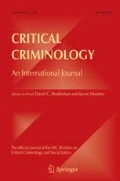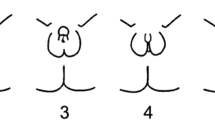Abstract
Legal regulations of the body produce and seek to protect specific imaginations of the body in an idealized form—that is, not only what a body is but also what it ought to be. In this article, we apply a queer criminological approach to interrogate the regulation of the body-that-ought-to-be that has animated two legal interventions regarding body modification: the criminalization of female genital cutting (FGC), often described in law as female genital mutilation (FGM), and the regulation of gender-affirming manual hormone use. By analyzing discourses that have circulated in Australian law regarding both practices, we show how the legitimacy of a given body modification has been tied to that modification’s potential to either threaten or affirm a body’s capacity to produce intelligible gender. We contend, on this basis, that the body that the law has sought to protect in these instances is a body that is not queer.
Similar content being viewed by others
Notes
FGC is also called “female circumcision.” On the importance of the distinction between FGC and FGM, see Ahmadu (2007). As we discuss later, the terms, “genital” and “female,” that are at work in the phrase, “female genital cutting,” also carry cis- and heteronormative as well as cultural assumptions. For further analysis, see Rogers (2009).
Gender affirmation generally refers to practices that assert or recognize a subject’s gender identity (Sevelius 2013). The terms “manual” and “automatic” are used here to signal that while many people use hormones that arise naturally in their body to help constitute their gender, many others use exogenous hormones to do so.
To date, the bulk of queer criminological work has studied the interaction of queer subjects with the criminal justice system unilaterally rather than reflexively, focusing on the repressive effects that legal regulations have upon queer populations rather than on understanding how queer populations, as well as the norms that define them, come into being as the effect of such regulations (Ball 2014, 2016; Dalton 2016; Woods 2014).
Re Alex: 176 (citing Re Jane [1988] FamCA 57 and Department of Health & Community Services v JWB & SMB (otherwise known as “Marion’s Case”) [1992] HCA 15) (our emphasis).
Section 45 was drafted hastily in 1996 (Rogers 2016) on the back of a large public outcry against FGM and during a consultation by the Family Law Council (Pardy et al. 2019; Rogers 2013). The vagaries of Section 45 would produce the conflicting decisions on this case that resulted finally in a High Court judgment in 2019: R v A2; R v Magennis; R v Vaziri [2019] HCA 35 16 October 2019 [56].
As the prosecution noted, the medical expert’s comments “did not exclude the possibility that there had been an injury which effectively had healed without any evidence of it having occurred” (R v A2; R v KM; R v Vaziri, 2012/00280081; 2012/0028455; 2012/00285639 14 September 2015 (Trial Transcript, Supreme Court of NSW Common Law Division, Johnson J) 66).
As the appellants argued, “the way one would get to ‘mutilates’ will vary because of the subject matter. That is to say that because you are dealing with a very sensitive part of the anatomy, it is going to be a lot easier to mutilate that part of the anatomy than it might be, say, an arm or a leg” (R v A2; R v Magennis; R v Vaziri [2019] HCATrans 122 (12 June 2019)).
See Rogers (2019) for further discussion of the teleological presumptions about the clitoris expressed in Vaziri and Magennis.
This may or may not be the way that Alex understood his gender and his desire for body modification, but we are not interested in questioning the terms by which Alex understands his own experience (see Bettcher 2009). Rather, we are interested in the function that these statements perform in law.
As an example, see NSW Crimes Act 1900, Section 45.
Our analysis of these statements does not intend to efface or denigrate those who pursue manual hormonal gender affirmation because they feel that they are trapped in the wrong body. Indeed, Prosser (1998: 68–79) defends the subjective use of the “wrong body” narrative on this account, arguing that some “transsexuals continue to deploy the image of wrong embodiment because being trapped in the wrong body is simply what transsexuality feels like.” Rather, our analysis is intended to show how such statements are wielded by law to arbitrate the conditions under which claims to gender affirmation are legally legitimized.
Notably, the un-circumcised vulva that appears in a diagram in the Family Law Council’s (1994b: 6) report is described as a “normal adolescent vulva.”
See discussions of irreparability as it relates to criminal law in R v A2; R v Magennis; R v Vaziri [2019] HCATrans 122 (12 June 2019).
References
Ahmadu, F. (2007). “Ain’t I a Woman Too?” Challenging Myths of Sexual Dysfunction in Circumcised Women. In Y. Hernlund & B. Shell-Duncan (Eds.), Transcultural Bodies: Female Genital Cutting in Global Context (pp. 278–310). New Brunswick, NJ: Rutgers University Press.
Ball, M. (2016). Criminology and Queer Theory: Dangerous Bedfellows? London: Palgrave MacMillan.
Bettcher, T.M. (2009) Trans Identities and First-Person Authority. In L. J. Shrage (Ed.), You’ve Changed: Sex Reassignment and Personal Identity (pp. 98–120). New York: Oxford University Press.
Bird, J. (2005). Outside the Law: Intersex, Medicine and the Discourse of Rights. Cardozo Journal of Law & Gender, 12(1), 65–80.
Butler, J. (1993). Bodies That Matter: On the Discursive Limits of ‘Sex’. Abingdon, Oxon, UK, and New York: Routledge.
Butler, J. (1999). Gender Trouble: Feminism and the Subversion of Identity. 2nd ed. Abingdon, Oxon, UK, and New York: Routledge.
Connell, R. (2015). Meeting at the Edge of Fear: Theory on a World Scale. Feminist Theory, 16(1), 49–66.
Cosmopolitan. (1994). Like a Virgin: Intimate Plastic Surgery. Cosmopolitan, September 18.
Dalton, D. (2007). Policing Outlawed Desire: ‘Homocriminality’ in Beat Spaces in Australia. Law and Critique, 18(3), 375–405.
Dalton, D. (2016). Reflections on the Emergence, Efficacy, and Value of Queer Criminology. In A. Dwyer A, M. Ball, & T. Crofts (Eds.), Queering Criminology (pp. 15–35). Basingstoke, Hampshire, UK: Palgrave MacMillan.
Davidian, A. (2011). Beyond the Locker Room: Changing Narratives on Early Surgery for Intersex Children. Wisconsin Journal of Law, Gender Society, 26(1), 1–22.
Dwyer, A., Ball, M., & Crofts, T. (Eds). (2016). Queering Criminology. Basingstoke, Hampshire, UK: Palgrave Macmillan.
Earp, B.D. (2016). Between Moral Relativism and Moral Hypocrisy: Reframing the Debate on “FGM.” Kennedy Institute of Ethics Journal, 26(2), 105–144.
Engdahl, U. (2014). Wrong Body. TSQ: Transgender Studies Quarterly, 1(1–2), 267–269.
Family Law Council. (1994a). Female Genital Mutilation: A Report to the Attorney-General. Barton, ACT: Commonwealth of Australia. Retrieved on May 25, 2021, from https://catalogue.nla.gov.au/Record/333463.
Family Law Council. (1994b). Female Genital Mutilation: Discussion Paper. Barton, ACT: Commonwealth of Australia. Retrieved on May 25, 2021, from https://catalogue.nla.gov.au/Record/149276.
Fausto-Sterling, A. (2000). Sexing the Body: Gender Politics and the Construction of Sexuality. New York: Basic Books.
Gans, J. (2016). Modern Criminal Law of Australia. 2nd ed. Cambridge, UK: Cambridge University Press.
Grace, A.P. (2012). Queer Theory. In L. M. Given (Ed.), The SAGE Encyclopedia of Qualitative Research Methods (pp. 719–722). Thousand Oaks, CA: SAGE Publications.
Halperin, D.M. (1995). Saint Foucault: Towards a Gay Hagiography. New York: Oxford University Press.
Haraway, D.J. (1991). A Cyborg Manifesto: Science, Technology, and Socialist-Feminism in the Late Twentieth Century. In Simians, Cyborgs and Women: The Reinvention of Nature (pp. 149–181). Abingdon, Oxon, UK, and New York: Routledge.
Henry, S., & Milovanovic, D. (1996). Constitutive Criminology: Beyond Postmodernism. London: SAGE Publications.
Hermer, L. (2002). Paradigms Revised: Intersex Children, Bioethics & The Law. Annals of Health Law, 11, 195–236.
Heyes, C.J., & Latham, J.R. (2018). Trans Surgeries and Cosmetic Surgeries: The Politics of Analogy. TSQ: Transgender Studies Quarterly, 5(2), 174–189.
Hosken, F.P. (1982). The Hosken Report: Genital and Sexual Mutilation of Females. 3rd ed. Lexington, MA: Women’s International Network News.
Iribarne, M., & Seuffert, N. (2018). Imagined Legal Subjects and the Regulation of Female Genital Surgery. Australian Feminist Law Journal, 44(2), 175–201.
Kennedy, A. (2009). Mutilation and Beautification. Australian Feminist Studies, 24(60), 211–231.
Kroger, H. (2012). Female Genital Mutilation. Commonwealth of Australia Parliamentary Debates, Senate Hansard, 13 March (p. 1648). Canberra, ACT: Parliament of Australia.
Leonard, L. (2000). “We Did It for Pleasure Only”: Hearing Alternative Tales of Female Circumcision. Qualitative Inquiry, 6(2), 212–228.
Lugones, M. (2007). Heterosexualism and the Colonial/Modern Gender System. Hypatia, 22(1), 186–209.
Mahmood, S. (2012). Politics of Piety: The Islamic Revival and the Feminist Subject. Princeton, NJ: Princeton University Press.
McDonald D. (2016). Who is the Subject of Queer Criminology? Unravelling the Category of the Paedophile. In A. Dwyer, M. Ball, & T. Crofts (Eds.) Queering Criminology (pp. 102–120). Basingstoke, Hampshire, UK: Palgrave MacMillan.
Mohanty, C.T. (2003). Feminism Without Borders: Decolonizing Theory, Practicing Solidarity. Durham, NC: Duke University Press.
Newbould, M. (2016). When Parents Choose Gender: Intersex, Children, and the Law. Medical Law Review, 24(4), 474–496.
Neyer, G., & Bernardi, L. (2011). Feminist Perspectives on Motherhood and Reproduction. Historical Social Research, 36(2), 162–176.
Pardy, M., Rogers, J., & Seuffert, N. (2019). Perversion and Perpetration in Female Genital Mutilation Law: The Unmaking of Women as Bearers of Law. Social & Legal Studies, 29(2), 273–293.
Peterson, D., & Panfil, V.R. (2014). Introduction: Reducing the Invisibility of Sexual and Gender Identities in Criminology and Criminal Justice. In D. Peterson & V. R. Panfil (Eds.) Handbook of LGBT Communities, Crime and Justice (pp. 3–13). New York: Springer.
Pitts, V. (2000). Visibly Queer: Body Technologies and Sexual Politics. Sociological Quarterly, 41(3), 443–463.
Prosser, J. (1998). Second Skins: The Body Narratives of Transsexuality. New York: Columbia University Press.
Rogers, J. (2009). “I love you…I mutilate you”: The Capture of Flesh and the Word in ‘Female Genital Mutilation’ Law. Analysis, 15, 37–53.
Rogers, J. (2013). Law’s Cut on the Body of Human Rights: Female Circumcision, Torture and Sacred Flesh. Abingdon, Oxon, UK, and New York: Routledge.
Rogers, J. (2019). What Constitutes Mutilation? – A concern with anti-Female Genital Mutilation laws in Australia and the question of natural function. Current Sexual Health Report, 11(4), 442–446.
Sevelius, J.M. (2013). Gender Affirmation: A Framework for Conceptualizing Risk Behavior Among Transgender Women of Color. Sex Roles, 68(11–12), 675–689.
Shildrick, M. (1997). Leaky Bodies and Boundaries: Feminism, Postmodernism and (Bio)Ethics. London: Routledge.
Spade, D. (2015). Normal Life: Administrative Violence, Critical Trans Politics, and the Limits of Law. 2nd ed. Durham, NC: Duke University Press.
Spivak, G.C. (1999). A Critique of Postcolonial Reason: Toward a History of the Vanishing Present. Cambridge, MA: Harvard University Press.
Stryker, S., & Sullivan. N. (2009). King’s Member, Queen’s Body: Transsexual Surgery, Self-Demand Amputation and the Somatechnics of Sovereign Power. In S. Murray & N. Sullivan (Eds.), Somatechnics: Queering the Technologisation of Bodies (pp. 49–64). Farham, Surrey, UK, and Burlington, VT: Ashgate.
Stychin, C.F. (1995). Law’s Desire: Sexuality and the Limits of Justice. London: Routledge.
Sullivan, N. (2007). “The Price to Pay for our Common Good”: Genital Modification and the Somatechnologies of Cultural (In)Difference. Social Semiotics, 17(3), 395–409.
Sullivan, N. (2008). The Role of Medicine in the (Trans)Formation of ‘Wrong’ Bodies. Body & Society, 14(1), 105–116.
Sullivan, N. (2009). Transsomatechnics and the Matter of ‘Genital Modifications’. Australian Feminist Studies, 24(60), 275–286.
Sullivan, N., & Murray, S. (Eds). (2009). Somatechnics: Queering the Technologisation of Bodies. Burlington, VT: Ashgate.
Walker, A., & Panfil, V.R. (2016). Minor Attraction: A Queer Criminological Issue. Critical Criminology: An International Journal, 25(1), 37–53. https://doi.org/10.1007/s10612-016-9342-7.
Woods, J.B. (2014). Queer Contestations and the Future of a Critical “Queer” Criminology. Critical Criminology: An International Journal, 22(1), 5–19. https://doi.org/10.1007/s10612-013-9222-3.
Author information
Authors and Affiliations
Corresponding author
Additional information
Publisher's Note
Springer Nature remains neutral with regard to jurisdictional claims in published maps and institutional affiliations.
Rights and permissions
About this article
Cite this article
Mitchell, M., Rogers, J. Prohibiting the Queer Body: Gender Affirmation, Female Genital Cutting, and the Promise of Gender Intelligibility. Crit Crim 29, 707–721 (2021). https://doi.org/10.1007/s10612-021-09580-2
Accepted:
Published:
Issue Date:
DOI: https://doi.org/10.1007/s10612-021-09580-2




